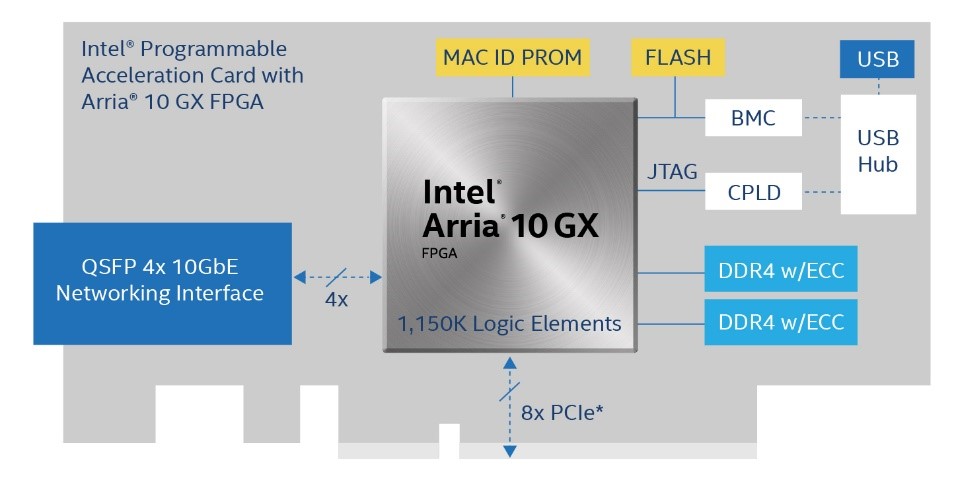Intel Debuts Plug-in FPGA Platform for Data Center Adoption

Intel Programmable Acceleration Card
While most of the enterprise computing world – users and vendors – ride CPU and GPU ponies around the data center merry-go-round, the brass ring of ultra-fast processing and lower power consumption would be to bring FPGAs into mainstream frameworks, enabling this thoroughbred racehorse of compute to handle massively parallelized hardware offloading without extensive programming agony.
With a view toward supporting complex, data-intensive applications, such as AI inference, video streaming analytics and database acceleration, Intel is making a push on the FPGA accessibility front. The company announced this week the Intel Programmable Acceleration Card, a hardware/software platform designed to enable customized FPGA-based acceleration of networking, storage and computing workloads.
The Intel PAC, which combines platforms, software stack and ecosystem solutions, abstracts the complexities of FPGA implementation, Intel said, to “enable architects and developers to quickly develop and deploy power-efficient acceleration of a variety of applications and workloads.”
 Intel PAC, which enables the Intel Arria 10 GX FPGA, has three major elements:
Intel PAC, which enables the Intel Arria 10 GX FPGA, has three major elements:
- Intel-qualified FPGA acceleration platforms that operate with Intel Xeon CPUs
- An “acceleration stack” for Intel Xeon CPU with FPGAs that provide industry standard frameworks, interfaces and optimized libraries
- An ecosystem of market-specific solutions
“The goal here is to supercharge the data center by delivering higher performance at lower TCO,” Bernhard Friebe, senior director of FPGA software solutions at Intel’s Programmable Solutions Group, told EnterpriseTech. “The key for us is to position FPGAs as a versatile accelerator because we can do so many things (with it) and the data center is inherently a workload-agnostic and very dynamic environment. You want to use your compute resources to full utilization, and the FPGA can do that.”
The Intel PAC, which plugs into Intel Xeon processor-based servers, is sampling now and is expected to be available in the first half of 2018. The platform approach enables OEMs to offer Intel Xeon processor-based server acceleration solutions with their unique value add.
“With this collaboration,” said Brian Payne, Dell EMC’s vice president, Product Management and Marketing, Server Solutions Division, “Dell EMC and Intel are combining a reliable platform with an emerging software ecosystem that provides a new technology capability for customers to unlock their business potential.”
Friebe said the acceleration stack provides an easy way to drop-in accelerator functions developed by the ecosystem for specific workloads. He said an emerging partner ecosystem is developing market-specific solutions in the areas of artificial intelligence, real-time big data analytics, video processing, financial acceleration, genomics and cybersecurity.
The acceleration stack provides a common developer interface for both application and accelerator function developers, and includes drivers, application programming interfaces (APIs), and an FPGA interface manager. It includes acceleration libraries and development tools aimed at saving developer time and enables code re-use across multiple Intel FPGA platforms.
According to Intel, early adopters include:
The Broad Institute, Cambridge, MA, which has seen a 50X algorithm speed up for genome sequencing compared to using Xeon E5 processors alone for the Pairwise HMM algorithm, previously a bottleneck in the genomic sequencing process
Swarm64, a relational database accelerator firm, which has seen a 10X boost in real-time data analytics for relational databases, which the company says projects to a roughly 40 percent TCO savings over three years
Attala, a cloud infrastructure specialist, which reports 57-72 percent lower latency for its NVMe-over-fabric storage platform










